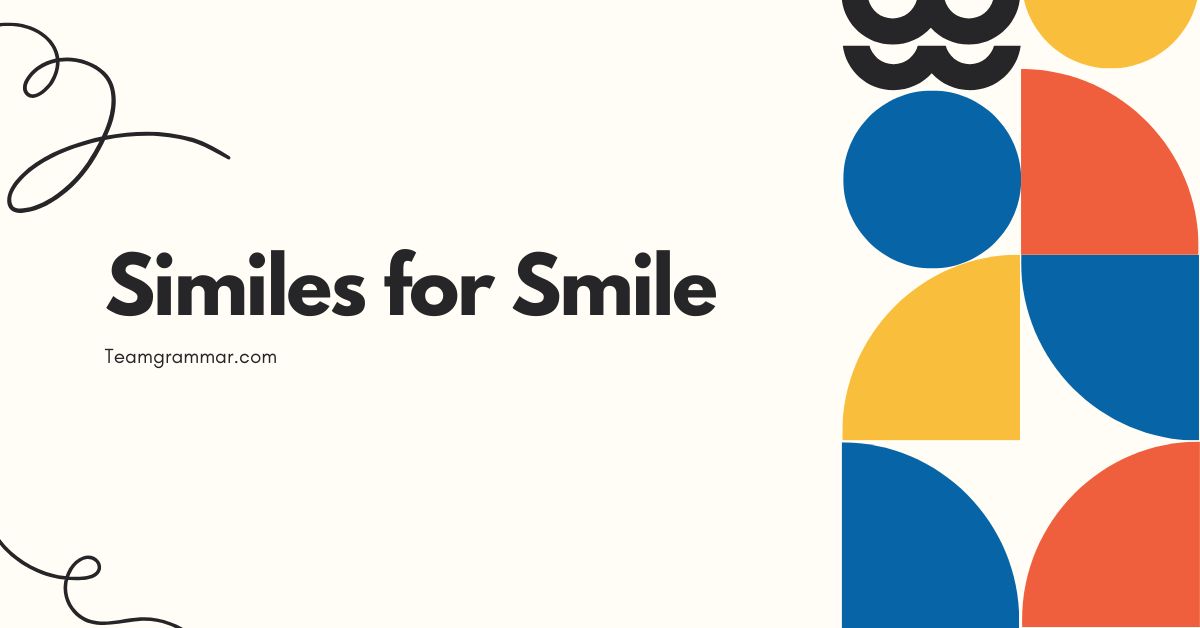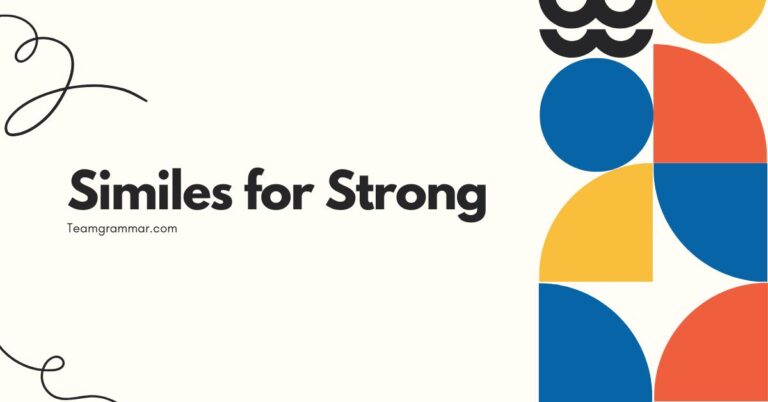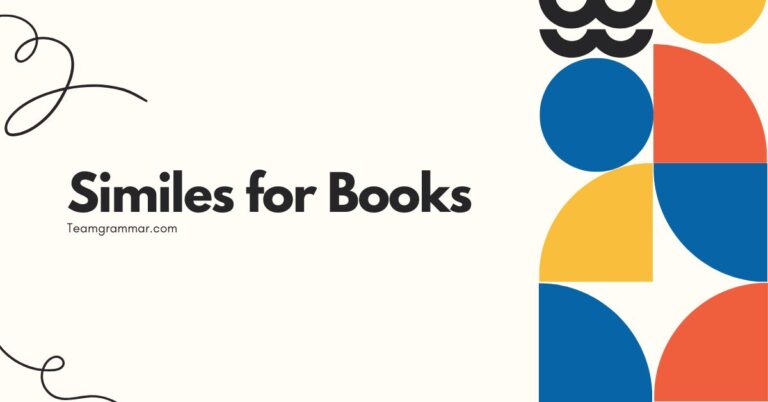27 Similes for Smile: Enhancing Your Descriptive Language
Understanding and using similes effectively can significantly enhance your descriptive writing and communication skills. Similes allow you to paint vivid pictures with words, making your language more engaging and memorable.
This article provides a comprehensive guide to similes for “smile,” exploring their various forms, usage rules, and creative applications. Whether you’re a student, writer, or simply someone looking to improve their English, this guide will equip you with the knowledge and practice to master the art of simile creation and enrich your vocabulary.
Table of Contents
- Introduction
- Definition of Simile
- Structural Breakdown of Similes
- Types of Similes
- Examples of Similes for Smile
- Usage Rules for Similes
- Common Mistakes with Similes
- Practice Exercises
- Advanced Topics in Similes
- Frequently Asked Questions (FAQ)
- Conclusion
Introduction
Similes are powerful tools in the English language that allow us to create vivid and engaging descriptions. By comparing one thing to another using words like “like” or “as,” we can evoke strong imagery and convey deeper meaning.
This article focuses specifically on similes used to describe a “smile,” exploring the various ways to capture its essence through creative comparisons. Understanding and using these similes effectively can greatly enhance your writing and communication skills.
This article is designed for English language learners, writers, and anyone interested in expanding their descriptive vocabulary.
Definition of Simile
Asimileis a figure of speech that compares two unlike things, often using the words “like” or “as.” The purpose of a simile is to create a vivid image or to emphasize a particular quality by drawing a parallel between the two things being compared. Similes are essential tools for descriptive writing, allowing authors and speakers to convey complex ideas and emotions in a relatable and engaging manner.
Unlike metaphors, which state that one thing *is* another, similes suggest a resemblance or similarity.
The function of a simile is to enhance understanding and create a stronger impact on the reader or listener. By using familiar concepts to describe unfamiliar ones, similes make abstract ideas more concrete and accessible.
They are frequently used in literature, poetry, and everyday conversation to add color, depth, and clarity to communication.
Similes can be found in various contexts, including:
- Literature: Used to create imagery and enhance the reader’s experience.
- Poetry: Employed to evoke emotions and convey deeper meanings.
- Everyday Conversation: Used to make descriptions more vivid and relatable.
- Advertising: Utilized to make products more appealing and memorable.
Structural Breakdown of Similes
The basic structure of a simile typically includes the following elements:
- The Subject: The thing being described (in our case, a smile).
- The Connecting Word: Usually “like” or “as.”
- The Object of Comparison: The thing the subject is being compared to.
- The Shared Quality: The characteristic that the subject and object of comparison have in common.
For example, in the simile “Her smile was like sunshine,” the subject is “her smile,” the connecting word is “like,” the object of comparison is “sunshine,” and the shared quality is brightness or warmth.
Understanding this structure helps in creating effective and meaningful similes. By carefully selecting the object of comparison and identifying the shared quality, you can craft similes that resonate with your audience and enhance your descriptions.
The key is to choose comparisons that are both apt and evocative, creating a clear and memorable image in the reader’s mind.
Let’s look at another example: “His smile was as radiant as the morning sun.” Here, “his smile” is the subject, “as…as” are the connecting words, “the morning sun” is the object of comparison, and the shared quality is radiance.
Types of Similes
Similes can be categorized based on the quality they emphasize or the effect they create. Here are a few common types:
Descriptive Similes
These similes focus on describing the physical appearance or characteristics of a smile. They aim to paint a vivid picture in the reader’s mind by comparing the smile to something visually striking or familiar.
Emotional Similes
These similes emphasize the emotional impact or feeling conveyed by a smile. They connect the smile to emotions such as happiness, joy, or comfort, helping the reader understand the emotional significance of the smile.
Comparative Similes
These similes highlight a specific trait or quality of the smile by comparing it to something known for that particular trait. For example, comparing a smile to a weapon to highlight its power or impact.
Hyperbolic Similes
These similes use exaggeration to emphasize the intensity or effect of a smile. They create a more dramatic and memorable image by using over-the-top comparisons.
Examples of Similes for Smile
Here are some examples of similes used to describe a smile, categorized by the type of quality they emphasize. Each category will include a table with 20-30 examples to give you a comprehensive overview.
Descriptive Similes
These similes paint a picture of the smile’s appearance, focusing on its visual qualities. They help the reader visualize the smile in a vivid and memorable way.
| Simile | Explanation |
|---|---|
| Her smile was like sunshine. | Implies the smile is bright, warm, and cheerful. |
| His smile was as radiant as the morning sun. | Suggests the smile is glowing and full of light. |
| Her smile was like a crescent moon. | Describes the shape of the smile as gentle and curved. |
| His smile was as bright as a lighthouse beam. | Indicates the smile is strong, guiding, and illuminating. |
| Her smile was like a painted rainbow. | Suggests the smile is colorful, beautiful, and fleeting. |
| His smile was as warm as a summer day. | Implies the smile is comforting and pleasant. |
| Her smile was like a blooming flower. | Suggests the smile is fresh, beautiful, and full of life. |
| His smile was as gentle as a soft breeze. | Indicates the smile is calm, soothing, and delicate. |
| Her smile was like a sparkling stream. | Suggests the smile is clear, refreshing, and lively. |
| His smile was as captivating as a starry night. | Implies the smile is mesmerizing and beautiful. |
| Her smile was like a burst of confetti. | Suggests the smile is joyful, celebratory, and unexpected. |
| His smile was as dazzling as a diamond. | Indicates the smile is brilliant, precious, and eye-catching. |
| Her smile was like a sunbeam through the clouds. | Suggests the smile is hopeful, uplifting, and rare. |
| His smile was as inviting as an open door. | Implies the smile is welcoming, friendly, and approachable. |
| Her smile was like a flash of lightning. | Suggests the smile is sudden, striking, and powerful. |
| His smile was as serene as a still lake. | Indicates the smile is peaceful, calm, and reflective. |
| Her smile was like a cascade of stars. | Suggests the smile is abundant, magical, and enchanting. |
| His smile was as pure as fresh snow. | Implies the smile is innocent, untainted, and clean. |
| Her smile was like a beacon in the night. | Suggests the smile is guiding, hopeful, and illuminating in darkness. |
| His smile was as genuine as a handwritten letter. | Indicates the smile is authentic, sincere, and heartfelt. |
| Her smile was like a perfectly ripe peach. | Suggests the smile is sweet, delightful, and satisfying. |
| His smile was as comforting as a warm fireplace. | Implies the smile is cozy, reassuring, and inviting. |
| Her smile was like a gentle ripple in a pond. | Suggests the smile is subtle, calming, and spreading. |
Emotional Similes
These similes focus on the emotional impact of the smile, connecting it to feelings and emotions. They help the reader understand the emotional significance of the smile.
| Simile | Explanation |
|---|---|
| Her smile was like a warm hug. | Implies the smile is comforting and affectionate. |
| His smile was as comforting as a mother’s embrace. | Suggests the smile is nurturing and reassuring. |
| Her smile was like a ray of hope in the darkness. | Indicates the smile is optimistic and uplifting. |
| His smile was as infectious as a child’s laughter. | Implies the smile is contagious and joyful. |
| Her smile was like a soothing balm. | Suggests the smile is healing and comforting. |
| His smile was as reassuring as a familiar song. | Implies the smile is comforting and calming. |
| Her smile was like a gentle reminder of happier times. | Suggests the smile is nostalgic and comforting. |
| His smile was as uplifting as a gospel choir. | Implies the smile is inspiring and joyful. |
| Her smile was like a burst of pure joy. | Suggests the smile is intensely happy and delightful. |
| His smile was as encouraging as a pat on the back. | Implies the smile is supportive and motivating. |
| Her smile was like a silent promise of better days. | Suggests the smile is hopeful and reassuring. |
| His smile was as heartening as a warm cup of tea. | Implies the smile is comforting and invigorating. |
| Her smile was like a gentle wave of peace. | Suggests the smile is calming and serene. |
| His smile was as invigorating as a breath of fresh air. | Implies the smile is refreshing and revitalizing. |
| Her smile was like a beacon of hope. | Suggests the smile is guiding and optimistic. |
| His smile was as calming as the sound of rain. | Implies the smile is peaceful and relaxing. |
| Her smile was like a warm blanket on a cold day. | Suggests the smile is comforting and protective. |
| His smile was as welcoming as a friendly handshake. | Implies the smile is inviting and approachable. |
| Her smile was like a sweet melody. | Suggests the smile is pleasant and harmonious. |
| His smile was as bright as a child’s eyes on Christmas morning. | Implies the smile is joyful and full of wonder. |
| Her smile was like a gentle nudge towards happiness. | Suggests the smile is encouraging and positive. |
| His smile was as reassuring as a lighthouse in a storm. | Implies the smile is steadfast and reliable. |
| Her smile was like receiving an unexpected gift. | Suggests the smile is delightful and surprising. |
Comparative Similes
These similes compare the smile to something known for a specific trait or quality, highlighting that particular aspect of the smile.
| Simile | Explanation |
|---|---|
| Her smile was as sharp as a knife. | Implies the smile is cutting, perhaps sarcastic or dangerous. |
| His smile was as fake as a plastic flower. | Suggests the smile is insincere and artificial. |
| Her smile was as rare as a blue moon. | Indicates the smile is infrequent and special. |
| His smile was as wide as the Grand Canyon. | Implies the smile is extremely broad and expansive. |
| Her smile was as mysterious as the Mona Lisa’s. | Suggests the smile is enigmatic and intriguing. |
| His smile was as fleeting as a shooting star. | Implies the smile is brief and transient. |
| Her smile was as bright as a supernova. | Suggests the smile is intensely radiant and powerful. |
| His smile was as steady as a rock. | Implies the smile is reliable and unwavering. |
| Her smile was as fragile as glass. | Suggests the smile is delicate and easily broken. |
| His smile was as disarming as a white flag. | Implies the smile is pacifying and non-threatening. |
| Her smile was as captivating as a siren’s song. | Suggests the smile is alluring and irresistible. |
| His smile was as comforting as a well-worn book. | Implies the smile is familiar and reassuring. |
| Her smile was as warm as a crackling fire. | Suggests the smile is inviting and comforting. |
| His smile was as genuine as a handshake. | Implies the smile is sincere and honest. |
| Her smile was as unexpected as a summer snowfall. | Suggests the smile is surprising and unusual. |
| His smile was as contagious as the common cold. | Implies the smile is easily spread and infectious. |
| Her smile was as sweet as honey. | Suggests the smile is delightful and pleasing. |
| His smile was as innocent as a newborn baby. | Implies the smile is pure and untainted. |
| Her smile was as powerful as a king’s decree. | Suggests the smile has authority and impact. |
| His smile was as subtle as a whisper. | Implies the smile is understated and delicate. |
| Her smile was as invigorating as a morning swim. | Suggests the smile is refreshing and energizing. |
| His smile was as reliable as the sunrise. | Implies the smile is dependable and consistent. |
| Her smile was as welcoming as a home-cooked meal. | Suggests the smile is inviting and comforting. |
Usage Rules for Similes
Using similes effectively requires understanding a few key rules:
- Use “like” or “as”: Always use these words to connect the subject and object of comparison.
- Compare unlike things: The things being compared should be different enough to make the comparison interesting and insightful.
- Ensure the comparison is clear: The shared quality between the subject and object should be easily understood by the reader.
- Avoid clichés: Try to avoid overused similes that have lost their impact. Opt for fresh and original comparisons.
- Consider the context: Make sure the simile is appropriate for the tone and style of your writing.
Exception:Sometimes, similes can be implied rather than explicitly stated. This is more common in poetry and creative writing, where the comparison is subtly suggested through imagery and word choice.
However, for clarity and directness, it’s generally best to use “like” or “as” in most contexts.
Common Mistakes with Similes
Here are some common mistakes people make when using similes, along with corrections:
| Incorrect | Correct | Explanation |
|---|---|---|
| Her smile is sunshine. | Her smile is like sunshine. | This is a metaphor, not a simile. Similes require “like” or “as.” |
| His smile was as happy. | His smile was as happy as a child. | The comparison needs a clear object to compare to. |
| Her smile was like a smile. | Her smile was like a blooming flower. | The objects being compared should be different to create an interesting comparison. |
| His smile was as big. | His smile was as big as a house. | Missing the object of comparison, making the simile incomplete. |
| Her smile was very sunshine. | Her smile was like sunshine. | Incorrect use of words to form the simile. |
Practice Exercises
Test your understanding of similes with these practice exercises. Fill in the blanks to complete the similes, or create your own similes to describe a smile.
Exercise 1: Fill in the Blanks
Complete the following similes with appropriate endings.
| Question | Answer |
|---|---|
| Her smile was like __________. | Her smile was like sunshine. |
| His smile was as comforting as __________. | His smile was as comforting as a warm blanket. |
| Her smile was as rare as __________. | Her smile was as rare as a blue moon. |
| His smile was like a __________. | His smile was like a gentle breeze. |
| Her smile was as bright as __________. | Her smile was as bright as a star. |
| His smile was like __________. | His smile was like a ray of hope. |
| Her smile was as sweet as __________. | Her smile was as sweet as honey. |
| His smile was as genuine as __________. | His smile was as genuine as a handshake. |
| Her smile was like __________. | Her smile was like a blooming flower. |
| His smile was as warm as __________. | His smile was as warm as a summer day. |
Exercise 2: Create Your Own Similes
Write your own similes to describe a smile, using the words “like” or “as.”
| Question | Answer |
|---|---|
| Write a simile to describe a joyful smile. | Her smile was like a burst of confetti. |
| Write a simile to describe a comforting smile. | His smile was as comforting as a warm cup of tea. |
| Write a simile to describe a rare smile. | Her smile was as rare as a shooting star. |
| Write a simile to describe a gentle smile. | His smile was like a soft breeze. |
| Write a simile to describe a bright smile. | Her smile was as bright as the sun. |
| Write a simile to describe a hopeful smile. | His smile was like a beacon in the night. |
| Write a simile to describe a sweet smile. | Her smile was as sweet as a ripe mango. |
| Write a simile to describe a genuine smile. | His smile was as genuine as a child’s laughter. |
| Write a simile to describe a beautiful smile. | Her smile was like a work of art. |
| Write a simile to describe a warm smile. | His smile was as warm as a roaring fire. |
Advanced Topics in Similes
For advanced learners, consider exploring these more complex aspects of similes:
- Implied Similes: These are similes where the “like” or “as” is omitted, leaving the comparison to be inferred by the reader.
- Extended Similes: These are similes that are developed over several lines or paragraphs, providing a more detailed and nuanced comparison.
- Subverted Similes: These are similes that intentionally defy expectations, creating a surprising or humorous effect.
- The use of similes in different genres and styles: How similes are used in poetry differs from how they are used in scientific writing.
Frequently Asked Questions (FAQ)
- What is the difference between a simile and a metaphor?
A simile uses “like” or “as” to compare two things, while a metaphor states that one thing *is* another. For example, “Her smile is like sunshine” (simile) vs. “Her smile is sunshine” (metaphor).
- Can a simile be a cliché?
Yes, if a simile is overused and has lost its impact, it can become a cliché. It’s best to avoid clichés and opt for fresh and original comparisons.
- How can I create better similes?
To create better similes, focus on finding unique and insightful comparisons. Think about the qualities you want to emphasize and look for objects or concepts that share those qualities in an interesting way. Also, read widely to expose yourself to different styles of writing and expand your vocabulary.
- Is it necessary to always use “like” or “as” in a simile?
While “like” or “as” are the most common markers of a simile, implied similes can omit these words, leaving the comparison to be inferred. However, for clarity, it’s generally best to use “like” or “as.”
- Are similes only used in literature?
No, similes are used in various forms of communication, including everyday conversation, advertising, and scientific writing. They are versatile tools for enhancing description and clarity.
- How do I avoid making my similes sound awkward?
To avoid awkward similes, make sure the comparison is logical and the shared quality is clear. Choose objects of comparison that are relevant and appropriate for the context. Read your similes aloud to check for rhythm and flow.
- What is the purpose of using similes in writing?
Similes enhance writing by creating vivid imagery, clarifying complex ideas, and adding emotional depth. They make descriptions more engaging and memorable, helping readers connect with the text on a deeper level.
- Can a simile be used incorrectly?
Yes, a simile can be used incorrectly if the comparison is illogical, unclear, or inappropriate for the context. It’s important to ensure that the simile makes sense and effectively conveys the intended meaning.
- How do extended similes differ from regular similes?
While regular similes make a direct comparison in a single phrase or sentence, extended similes develop the comparison over multiple sentences or even paragraphs. This allows for a more detailed and nuanced exploration of the similarities between the two things being compared.
- What role do similes play in poetry?
Similes are critical in poetry for adding layers of meaning and sensory detail. Poets use similes to evoke emotions, create vivid images, and convey complex ideas in a concise and impactful way, enriching the reader’s experience of the poem.
Conclusion
Mastering the use of similes, particularly those describing a “smile,” can significantly enhance your descriptive writing and communication skills. By understanding the structure, types, and usage rules of similes, you can craft vivid and engaging comparisons that resonate with your audience.
Remember to avoid clichés, consider the context, and practice creating original and insightful similes. With consistent effort and attention to detail, you can elevate your language and express yourself with greater clarity and creativity.
Continue to explore and experiment with different similes to expand your vocabulary and refine your writing style. Pay attention to how skilled writers use similes in their work and draw inspiration from their techniques.
By incorporating similes into your writing, you can add depth, color, and impact to your words, making your communication more effective and memorable. The world of similes is vast and rewarding, offering endless opportunities for creative expression.







